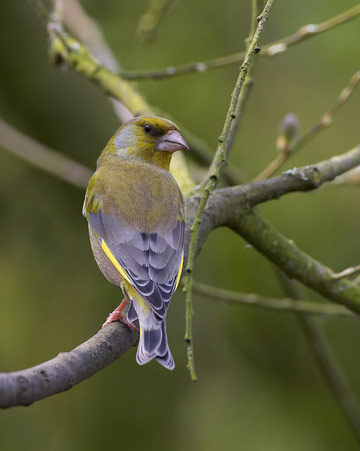
Greenfinch © Richard Steel
A century ago, Coward (1910) described the Greenfinch as an abundant resident and partial migrant, and wrote ‘in winter, though a few may be met with, it is scarce in most parts of Cheshire’. Migratory parties appeared from the beginning of March, and birds left again in September and October. At some stage they must have substantially shifted from being ‘scarce in most parts of Cheshire’ to their present status as one of our commonest and most widespread wintering species, but this change was not documented. Bell (1962) agreed that Coward’s summary adequately described the Greenfinch’s status although Boyd (1951) had called it ‘… one of the most plentiful birds in the district (around Great Budworth) throughout the year’, with flocks of hundreds of Greenfinches noticeable from November to February. Since Coward’s time almost two million Greenfinches have been ringed in Britain and Ireland and we now know that most of them are sedentary or make short movements up to 20 km, which might not be much farther than their daily foraging or roosting distances. Fewer than one-in-five birds moves more than 20 km, a clear difference from one hundred years ago. Some Norwegian birds cross to Britain, although few penetrate beyond the east coast, but some British birds move west or southwest for the winter and augment our resident population (Migration Atlas).
This Atlas survey shows Greenfinch to be the 14th most widespread species in winter in the county. The map shows them present in sixteen tetrads in which they were not recorded during the breeding season, but they were missing from 38, a net loss of 22 tetrads: these were scattered across the county and perhaps attributable to birds joining flocks outside the tetrad. They are scarce in the uplands (BTO Winter Atlas) and moved out of seven of the tetrads above 250 m, but on the other hand birds were found in four other high-altitude tetrads where they had not bred. Their recorded distribution across habitats was almost identical to the breeding season: human sites (45%), farmland (34%), woodland (14%) and scrub (8%). Their winter diet is seeds, especially those at the larger end of the size range such as rose hips, brambles and yew berries. In gardens they can dominate feeders and bird tables providing peanuts and sunflower seeds.
Most Greenfinches in winter join flocks, although many records were just of one or two birds, and the median count was three birds. Fieldworkers logged 24 feeding flocks of 50 or more, including seven flocks of 150 or more, with a maximum of 150-200 birds estimated by Chris Hancock at Whitley Reed (SJ68L). Communal roosts are a regular feature of Greenfinch behaviour in winter, but they were reported from only 16 tetrads. Three of them had flocks estimated larger than 100 birds, all in urban situations, found by Brian Martin in a holly tree in Warrington cemetery and by Colin Lythgoe in laurels in two different sites on either side of Crewe. Others were noted in yew, poplar and rhododendron and they will use any suitable bush or tree that provides sufficient shelter from wind and rain (Newton 1972).
Sponsored by Brenda and Michael Arnold

